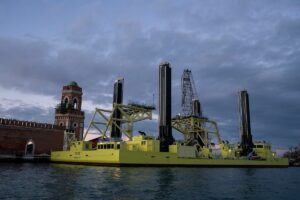Can we save our cities from climate disasters?

One portion of the MOSE structure; it rises more than five stories when fully extended.
I recently came across this article on the innovative flood system that the Italian government has adopted to safeguard Venice and its lagoon. While it’s a masterful feat of engineering, it does raise some questions on the limits of technology in truly solving climate change.
First, a bit of background. In the last 20 years, Venice has experienced 11 of its 20 largest flooding events. From the fairly benign flooding of the Piazza San Marco, these events have only gotten larger, and thus, it became obvious that the city needed some method of flood prevention. However, the area’s unique topology made this fairly basic technology quite difficult to engineer. The tidal lagoon that Venice sits in is essentially the city’s waste management system: as the tides approach and recede, they carry organic matter and waste out of the city’s myriad canals. Without this, the city would quickly turn fetid and unmanageable.
Thus, the MOSE system was born. It consists of nearly a mile of 5-story floodgates that expand from below the water’s surface when the forecast shows that extreme tides are imminent. However, even this innovative system is quickly being made obsolete. Its bones were first designed in the mid 1990s, when projections for total sea level rise were fairly optimistic, at least relative to current ones. Coupled with a faster-than-expected rise in aquifer usage (sinking the ground under the city), this means that MOSE might become obsolete by the middle of the century, instead of its projected 80-year lifespan.
And herein lies the question of technology’s utility in combatting climate change. If such an ambitious and well thought out system has the potential to be nearly worthless within 40 years, is it possible to create lasting reactionary solutions to climate change? At present rates, sea level rise will keep accelerating, forcing us to build increasingly complex and carbon-intensive solutions. And as an economics lens shows, trying to solve a problem by creating more of what initially caused the problem is an exercise in futility.
So, it seems clear that the only way technology can solve climate change is by mitigating it at the source. Venice helps show us that post facto solutions like this one are at best band-aids on a gaping wound.
- Categories: